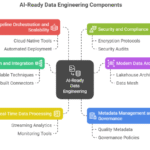The Fierce Competition for Top Talent
The U.S. life sciences sector is a hotbed of innovation, but this also means intense competition for skilled professionals. Companies looking to hire in the U.S. often find that top candidates are fielding multiple offers, sometimes from major tech firms as well as direct competitors. It’s not uncommon for sought-after individuals in biotech hubs like Boston or the Bay Area to receive numerous recruiter inquiries weekly. This high demand means that simply posting a job opening isn’t enough; a proactive and strategic approach is necessary to stand out in this crowded market.
The talent isn’t just scarce; it’s often already committed elsewhere. This reality transforms recruitment into a high-stakes game where speed and a compelling value proposition are key. Companies must recognize that the U.S. talent pool is highly active, with professionals constantly evaluating new opportunities. Understanding this dynamic is the first step in developing an effective recruitment strategy.
The U.S. market presents a unique challenge where candidates are accustomed to being actively pursued. Simply listing a role can lead to it being overlooked amidst a flood of other opportunities.
Talent Shortages Across Key Sectors
Across the U.S. life sciences industry, significant talent gaps exist in critical areas. Reports indicate that a large percentage of companies face shortages in research and development, regulatory affairs, and clinical leadership. This isn’t just about filling seats; it’s about finding individuals with the precise blend of scientific knowledge, regulatory understanding, and leadership capability needed to drive projects forward.
The demand extends to professionals who can effectively communicate complex scientific data, manage interactions with regulatory bodies like the FDA, and lead diverse, cross-functional teams.Understanding how to navigate biotech challenges in USA often means partnering with firms like Pact & Partners, who specialize in identifying and placing talent that meets the industry’s evolving demands.
Finding candidates who possess this multifaceted skill set is a major hurdle. The need is often immediate, with companies eager to fill these roles to avoid project delays or stalled product launches. This creates a challenging environment where the right talent is both in high demand and short supply, making the recruitment process particularly demanding.
- R&D Specialists
- Regulatory Affairs Experts
- Clinical Trial Managers
- Biostatisticians
The High Stakes of U.S. Recruitment
Recruiting in the U.S. life sciences sector carries significant weight. The market is known for being the most competitive, expensive, and heavily regulated globally. This means that hiring decisions have a magnified impact, and the cost of a misstep can be substantial. Salaries are often higher, and the expectations for candidate performance are rigorous. For companies, especially those new to the U.S. market, underestimating the localized nature of hiring can lead to significant setbacks.
What works in other global biotech hubs may not translate directly to the U.S. The hiring process here is deeply influenced by region-specific expectations, compensation norms, and a complex web of legal and compliance requirements. Tailoring job specifications and understanding cultural nuances are not just helpful; they are critical for attracting and securing the right talent. The margin for error in U.S. recruitment is exceptionally slim.
Navigating Cultural Nuances in U.S. Hiring

American Candidate Self-Presentation
When U.S. candidates present themselves, it often comes across as direct and confident. This can sometimes be mistaken for arrogance by those unfamiliar with American hiring culture. It’s important to remember that this self-presentation is typically a sign of confidence, not necessarily overconfidence. Understanding this aspect of American candidate self-presentation is key to accurately assessing their suitability for a role.
Decoding Cultural Differences in Interviews
Interviews in the U.S. often focus on behavioral questions and past accomplishments. Candidates are expected to articulate their contributions and impact clearly. What might seem like boasting to some is simply the standard way of demonstrating capability in the American job market. Recognizing these differences helps in interpreting interview responses effectively.
Localizing Without Compromising Identity
Adapting hiring practices to the U.S. market doesn’t mean abandoning your company’s core values. It’s about finding a balance. This involves understanding U.S. expectations regarding job descriptions, compensation, and benefits, while still reflecting your unique company culture. Successful localization means making smart compromises to attract talent without losing what makes your organization distinct. This careful approach to localizing is vital for building a strong U.S. team.
Addressing U.S. Recruitment Complexities

The Illusion of Easily Available Talent
The U.S. life sciences market is often seen as a deep well of talent, but this perception can be misleading. Many foreign companies assume that simply posting a job opening will attract a flood of qualified candidates. However, the reality is far more complex. The competition for top-tier professionals is intense, with many individuals already engaged with multiple opportunities, often from well-established domestic companies or even Big Tech firms. This means that the talent you’re targeting is likely fielding numerous offers, making your company’s proposition stand out a significant challenge.
The U.S. isn’t just another market; it’s the most competitive, expensive, and heavily regulated life sciences ecosystem globally. This environment means the stakes are considerably higher. Salaries are steeper, and the margin for error in hiring decisions is nearly zero. What might work in other global hubs often falls short in the U.S. due to a unique blend of region-specific expectations, compensation standards, and compliance hurdles. Simply getting your job specifications “Americanized” is a strategic task in itself, requiring careful tailoring to meet local expectations.
The Need for Customized Recruitment Strategies
Most foreign CEOs underestimate how localized and fragmented the hiring process is in the United States. What works in Lyon, Basel, London, Seoul, or Tel Aviv does not necessarily work in Boston or the Bay Area. Each organization in the life sciences sector requires a customized recruitment approach to address its unique challenges and market position. This means adapting not just job descriptions but also the entire candidate experience.
Recruiting in life sciences in the U.S. is hard, especially for foreign companies trying to attract top talent. Clinical trials can stall, and product launches can be delayed if the right people aren’t in place. A one-size-fits-all approach to recruitment simply won’t cut it. Instead, companies need to develop tailored strategies that account for the specific demands of the U.S. market and the particular needs of their organization.
Beyond the Resume: Skills and Cultural Fit
When evaluating candidates, it’s important to look beyond the traditional resume. Americans are often trained to present themselves confidently, which might be perceived as arrogance by some international hiring managers. Understanding this cultural nuance is key to accurately interpreting candidate profiles and interview performance. The ability to assess not just technical skills but also cultural alignment is paramount for building a cohesive and effective team.
A surprisingly common issue in biotech hiring is misalignment between the Board and operational leadership on what the hire should accomplish. Clarifying these objectives upfront is vital.
Identifying candidates who can successfully navigate these cultural differences and align with your company’s ethos is crucial. This involves a deeper dive into their communication style, problem-solving approaches, and overall adaptability. A strong cultural fit, combined with the necessary skills, is what truly drives long-term success in U.S. biotech recruitment.
Key Challenges in U.S. Biotech Recruitment
Region-Specific Expectations and Compensation
When looking to hire in the U.S. life sciences sector, companies must understand that expectations and compensation are not uniform. What works in one biotech hub might not fly in another. Salaries, benefits, and even the perceived value of certain roles can vary significantly based on location. This means a one-size-fits-all approach to recruitment simply won’t cut it. Companies need to research and adapt their compensation packages to align with regional standards to attract top talent.
Compliance Hurdles and Legal Frameworks
Navigating the U.S. legal landscape for hiring is a significant challenge. Companies must be aware of and comply with a complex web of federal and state labor laws, including those related to immigration, visas, equal employment opportunity, and benefits. Failure to adhere to these regulations can lead to costly penalties and delays. Understanding and managing these compliance hurdles is non-negotiable for successful U.S. recruitment.
The “Americanization” of Job Specifications
Job descriptions often need to be adapted to resonate with the American workforce. This involves more than just translating terms; it means understanding cultural nuances in how roles are presented, responsibilities are framed, and career progression is outlined. What might be standard in another country could be perceived differently by U.S. candidates. Tailoring job specifications to meet these U.S. expectations is critical for attracting the right talent pool.
Strategies for Successful U.S. Hiring
Smart Compromises in Candidate Selection
Finding the perfect candidate in the U.S. life sciences market often means making smart compromises. It’s rare to find someone who ticks every single box. Instead, focus on core competencies and potential. A candidate might lack a specific software skill but possess exceptional problem-solving abilities and a strong scientific background. Prioritizing these transferable skills can lead to a more adaptable and valuable team member. Remember, the goal is to build a strong team, not just fill a single role.
Don’t let the pursuit of a mythical unicorn candidate stall your progress. Instead, evaluate candidates based on their ability to grow and adapt within your organization. This approach to candidate selection is key to overcoming U.S. recruitment challenges.
Prioritizing Cultural Alignment and Onboarding
Beyond technical skills, cultural fit is paramount for U.S. hires. Americans often express confidence in ways that might seem boastful to other cultures, but it’s usually a sign of self-assurance. Understanding these nuances helps in assessing candidates accurately. A strong onboarding process is also vital. It should clearly communicate company values, expectations, and provide resources for the new hire to succeed. This proactive approach helps integrate new team members smoothly and reduces early turnover.
- Clearly define company culture and values.
- Integrate cultural sensitivity training for hiring managers.
- Develop a structured onboarding plan that addresses both professional and cultural integration.
Leveraging Specialized Recruitment Partners
Partnering with specialized recruitment firms can significantly streamline the U.S. hiring process. These firms possess deep market knowledge, understand regional expectations, and have established networks. They can help tailor job specifications to attract the right talent and navigate complex compliance hurdles. A good partner acts as an extension of your team, providing strategic insights and access to a wider pool of qualified candidates. This is especially important when trying to recruit for specialized roles.
The U.S. hiring landscape is intricate, demanding more than just a resume review. It requires a strategic approach that considers cultural fit, regional nuances, and a deep understanding of the life sciences sector.
When seeking external help, look for partners who demonstrate a clear understanding of the biotech industry and a proven track record in the U.S. market. Their ability to decode job titles, compensation benchmarks, and regional expectations is invaluable. This strategic partnership is a smart compromise that can save time and resources, ultimately leading to more successful hires.
The Global Talent Crisis in Life Sciences
Intense Competition for Specialized Roles
The life sciences sector is facing a significant talent shortage. Many companies report difficulties finding qualified individuals, especially for roles in research and development, regulatory affairs, and clinical leadership. It’s not just about filling seats; it’s about finding people with the right scientific knowledge, regulatory experience, and leadership skills. Candidates in key biotech hubs often receive multiple recruiter inquiries weekly, highlighting the intense competition for top professionals.
The “Bidding War” for Biotech Professionals
Recruiting in life sciences has become a true “bidding war.” Professionals in leadership roles frequently get approached by recruiters, sometimes multiple times a week. This high demand means companies must offer competitive packages and clear career paths to attract and retain talent. The market is so tight that finding the right person can feel like a constant battle, with many candidates already fielding several offers.
Bridging Science and Technology Talent Gaps
Beyond specialized scientific roles, there’s also a growing need to bridge the gap between scientific expertise and technological proficiency. Companies require individuals who understand both cutting-edge science and the digital tools used in research, development, and data analysis. This dual skillset is becoming increasingly important, adding another layer of complexity to the already challenging U.S. recruitment landscape.
Final Thoughts on U.S. Recruitment
Bringing top talent into your U.S. biotech operation isn’t simple. The market here is tough, with many companies looking for the same skilled people. What works in other countries often doesn’t translate well to the U.S. hiring scene. Understanding local pay rates, what people expect from a job, and the rules you have to follow is key. It’s about more than just finding someone with the right skills; it’s about finding someone who fits your company culture and can handle the fast pace of U.S. life sciences. Getting this right means looking closely at how you present your jobs and what you offer, making sure it appeals to the candidates you really need. It’s a challenge, but with the right approach, building a strong U.S. team is definitely possible.

